Continue reading “Such Coup. Many Unconstitutional. So Thwart.”
Hardcore / Love, Leckey / Jafa

This has been hanging around on my instagram feed, but I just listened to Arthur Jafa and Mark Leckey talk about it on The Art Newspaper’s podcast, and now I must post.
This two-artist show titled Hardcore / Love at Conditions Studio Programme in Croydon brings together two of the most amazing works of video art of the century: Mark Leckey’s Fiorucci Made Me Hardcore (1999) and Arthur Jafa’s Love is the message, the message is death (2016).
The artists’ conversation with Ben Luke is unexpected and interesting, drawing affinities between these two works and the musical moments they inhabit. But also, as Mark points out, each film embodies the technology of its moment while marking a significant shift in media: from digital to analog, and from chronological to algorithmic.
I worry we’re too late for Jafa’s turn on NTS, the experimental radio station where Leckey has been programming for so long, and to such great effect. Maybe it’s archived. [here’s a direct soundcloud link]
Hardcore / Love is at The Whitgift Centre, Croydon, by Conditions, from 28 June through 10 August 2025 [conditions.studio]
Arthur Jafa & Mark Leckey on The Week In Art, with Ben Luke [theartnewspaper]
Arthur Jafa & Mark Leckey playlist 06.27.2025 [nts.live]
R.H. Quaytman Book Talk
A couple of weeks ago Miguel Abreu Gallery hosted a launch event for Book, the second volume of R.H. Quaytman’s catalogue raisonné/artist book, which covers her work through 2022.
I’ve always been interested in Quaytman’s accounts of being the child of a painter, and of inheriting the legacy—and full storage spaces—of her father Harvey Quaytman.
But that is not important now, because now all I want to hear about is the incredibly dynamic of being on a panel with your mom. Quaytman’s mother, the artist-turned-poet Susan Howe, absolutely ran away with this conversation, even as she managed to (mostly) keep the focus on her daughter and her book.
Which, she cannot believe she called her book Book, what was that about? Just when you think the family dynamic has ebbed, and the conversation has slipped back into typical panel mode, everyone jumps on the pile of discursive rubble trying to figure out what Benjamin meant with the Angel of History.
I hope there is a mother-daughter podcast in the works, because I’ve got $5/month burning a hole in my pocket rn.
R.H. Quaytman, Ones, Chapter 0.2, has been extended through July 12, 2025 [miguelabreugallery]
Previously, related: R.H. Quaytman, Paul Klee, and Martin Luther walk into a bar
George Inness, Industrial Niagara
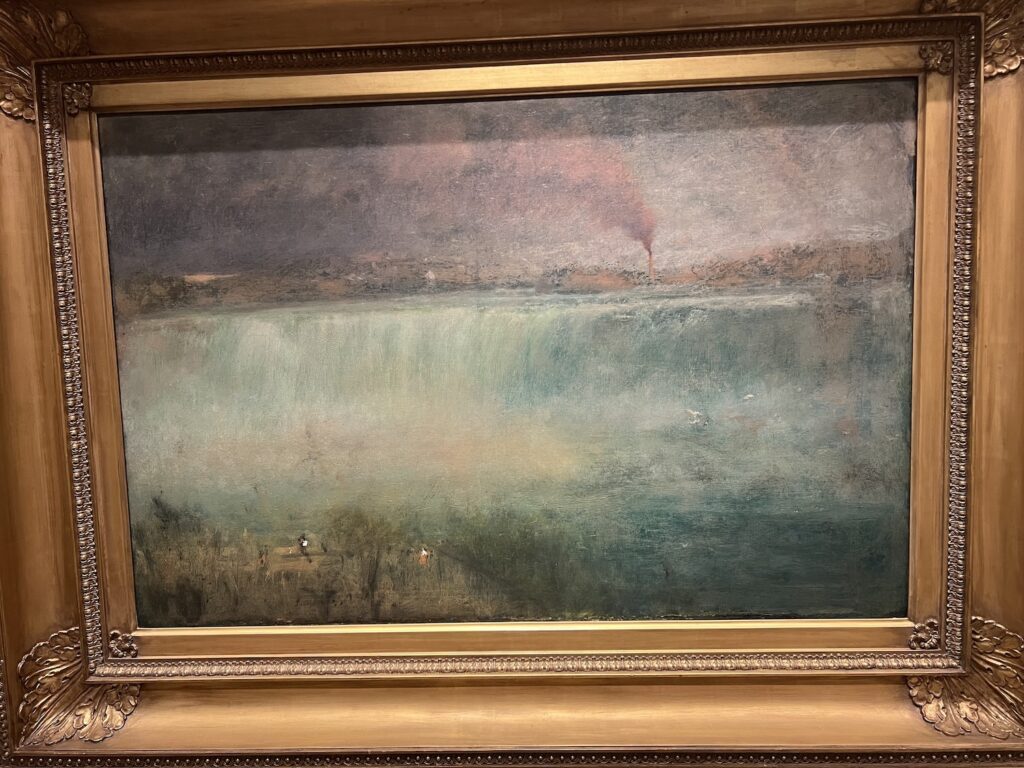
I had to go check something at the Smithsonian American Art Museum for a thing, and on the way, I got stopped by the tiny painters in the lower left corner of George Inness’s misty, smoky 1889 painting of Niagara. It had just recently been declared a state park, and the factories, mills, and brothels along the cataract had not yet been cleared away. Pretty sure it’s an edenic paradise now, at least from some angles.
どうでもええ… LV X YK Surfboards
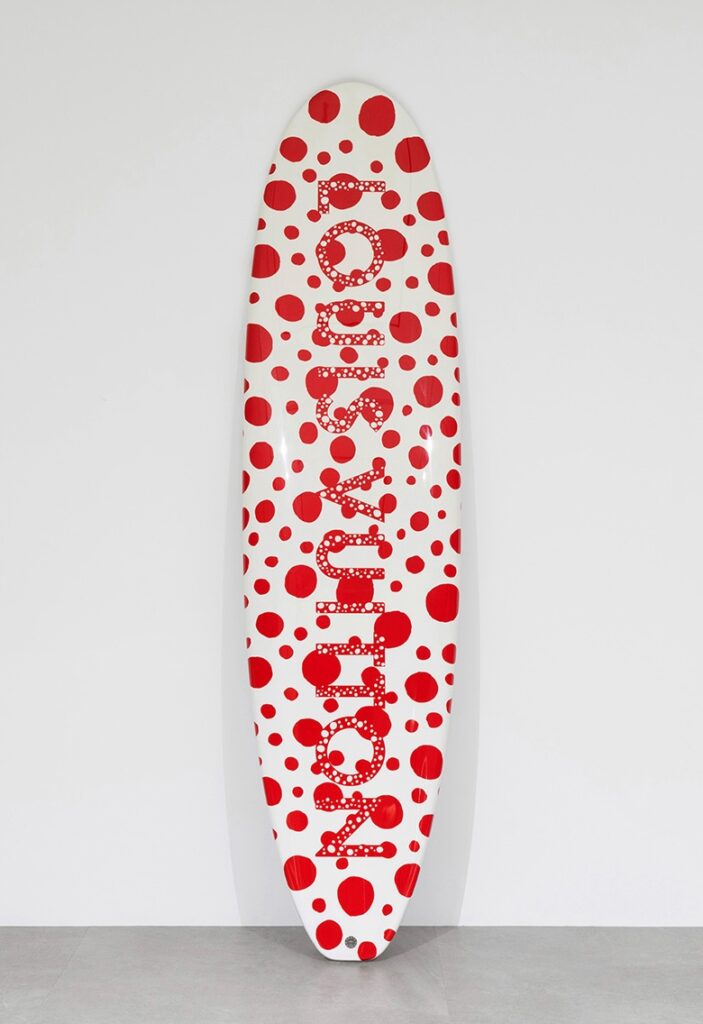
I could have gone another couple of years without realizing Louis Vuitton made several hundred Yayoi Kusama surfboards as part of their sprawling animatronic collabsploitation in 2023.
There’s a longboard and a shortboard variant, and at least two motifs: dots and tentacles. The PR copy regurgitated on all the hypesites says they’re a tribute to Kusama’s pumpkin sculpture on the dock at Naoshima. If that’s the true, then why aren’t they all destroyed in a typhoon?
12 July 2025 lot 69 [not nice] | LV x YK Surf (red & white), ed. 100, JPY1.5-2.5m [sbiauction]
Previously, all too related: Kusama X Vuitton: ‘I was finally able to bring home the crown’; The Infinity Room is now an LV Pop-up
Gavin Brown Woodblock Prints @ La Pulce
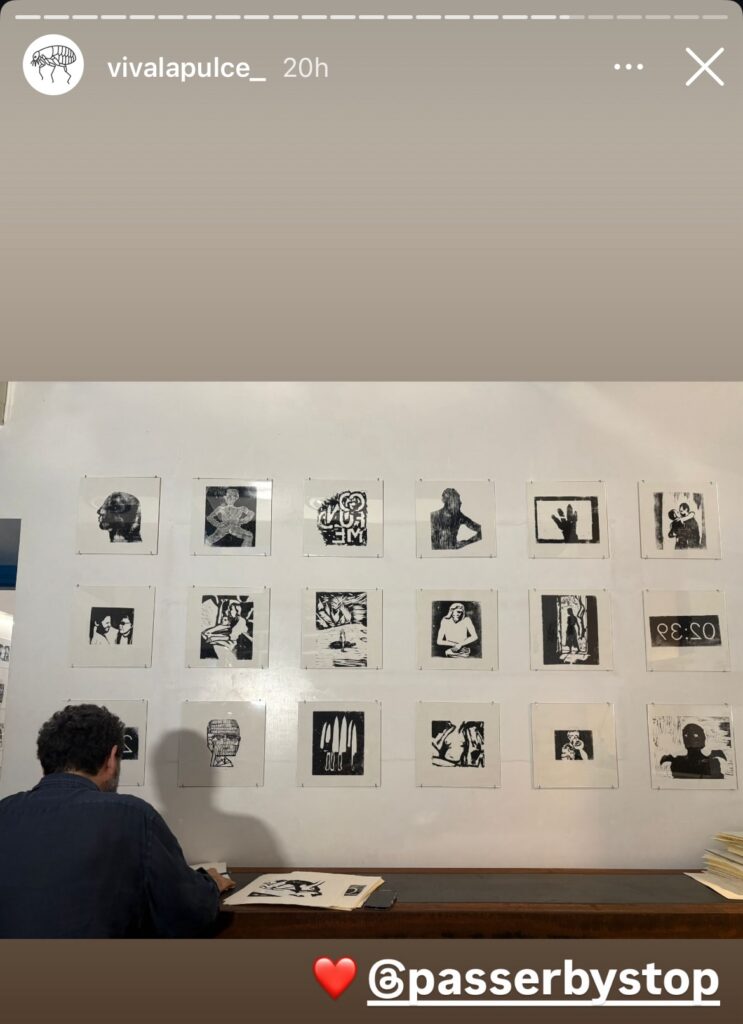
In the year 2000, on the small bookshelf in the grass-roofed house we rented on the beach in Tulum, was a years-old Gallery Guide, the monthly, pocket-sized directory of all the shows in all the galleries around town (NYC). Flipping through it, I was surprised to see Gavin Brown, a dealer friend, had had a show at David Zwirner. He was a bit cagey when I asked him about it later. I’m very glad that over the years, he has eased up, and has gotten back to showing work.
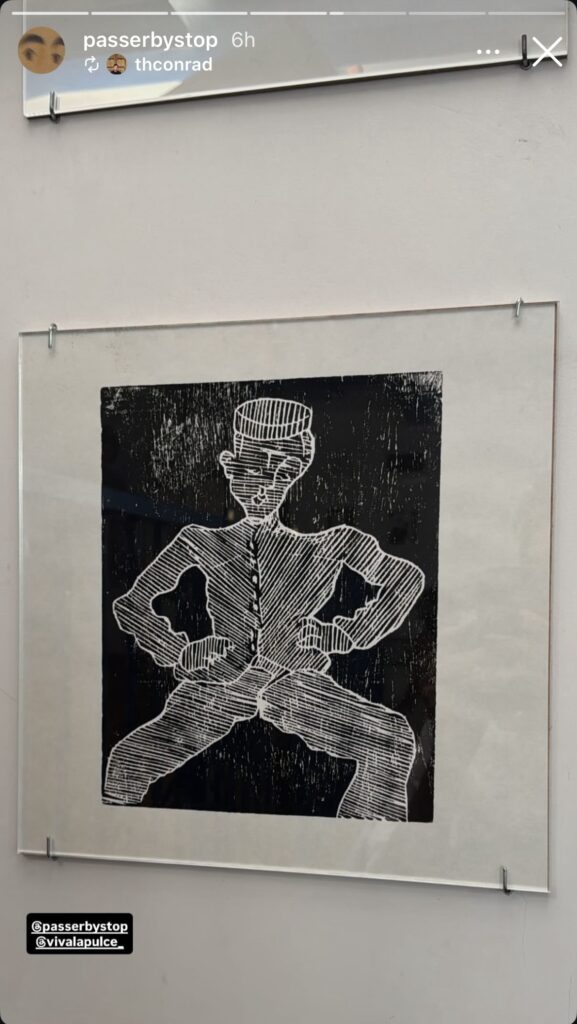
Last night Gavin opened Proof of Life, a show of woodblock prints at La Pulce, his second project/gallery space in Rome, which opened this spring. I could not make it, but I am glad to see the results spreading on instagram. Brown has turned to a laborious mediated process to make fleeting images of daily life. That perhaps included a trip at some point to the Pompidou, or to an exhibition somewhere one of my favorite Soutines was on loan.
Gavin Brown Proof Of Life is at La Pulce, Via Dei Tre Archi 5, Roma, till idk [ig]
Deliberation Before Action Protects You From Regret
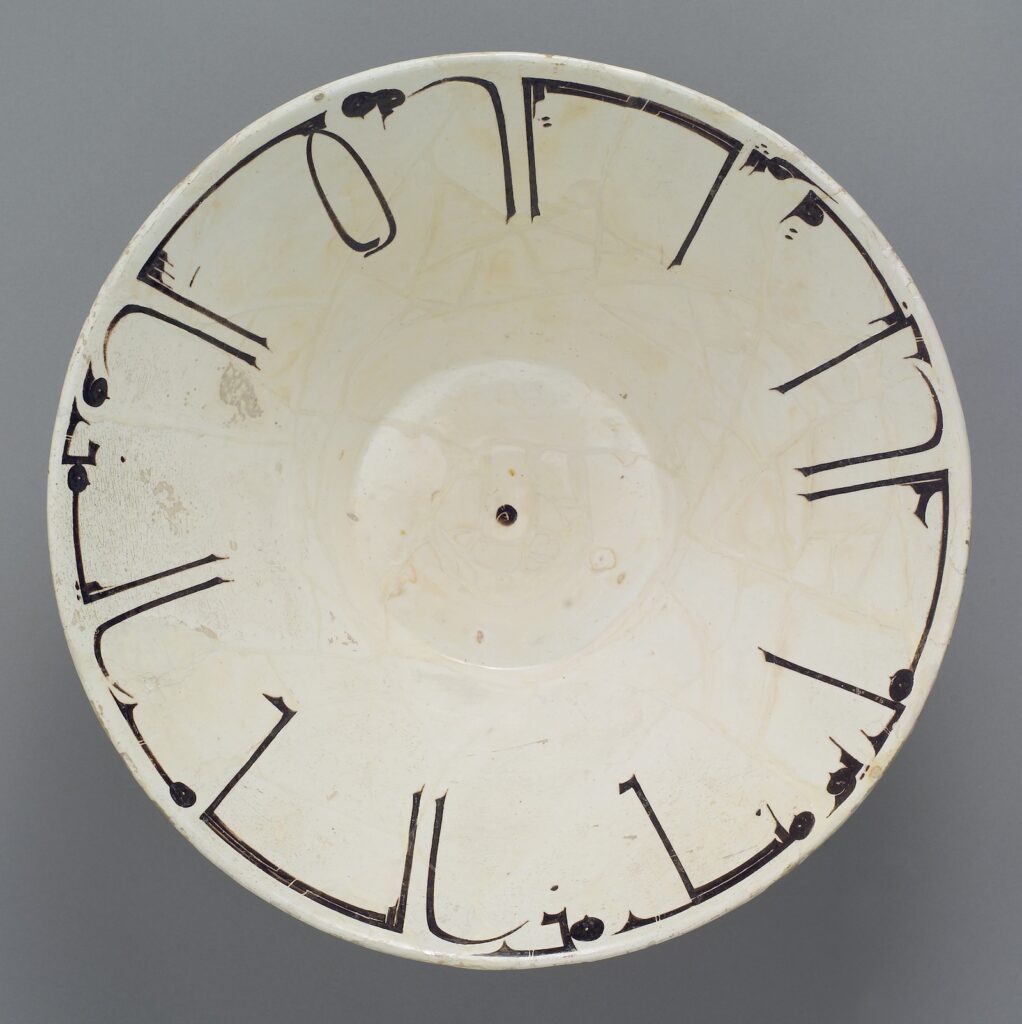
The new-style Kufic calligraphy on this 10th century bowl is glorious. It translates to “Deliberation before action protects you from regret; good fortune and good health.” I’m assuming that’s not an Oxford semicolon.
Here is a reading and translation that follows along the inscription.
[via @sarcher.bsky.social]
Four Nudes, No Drinks
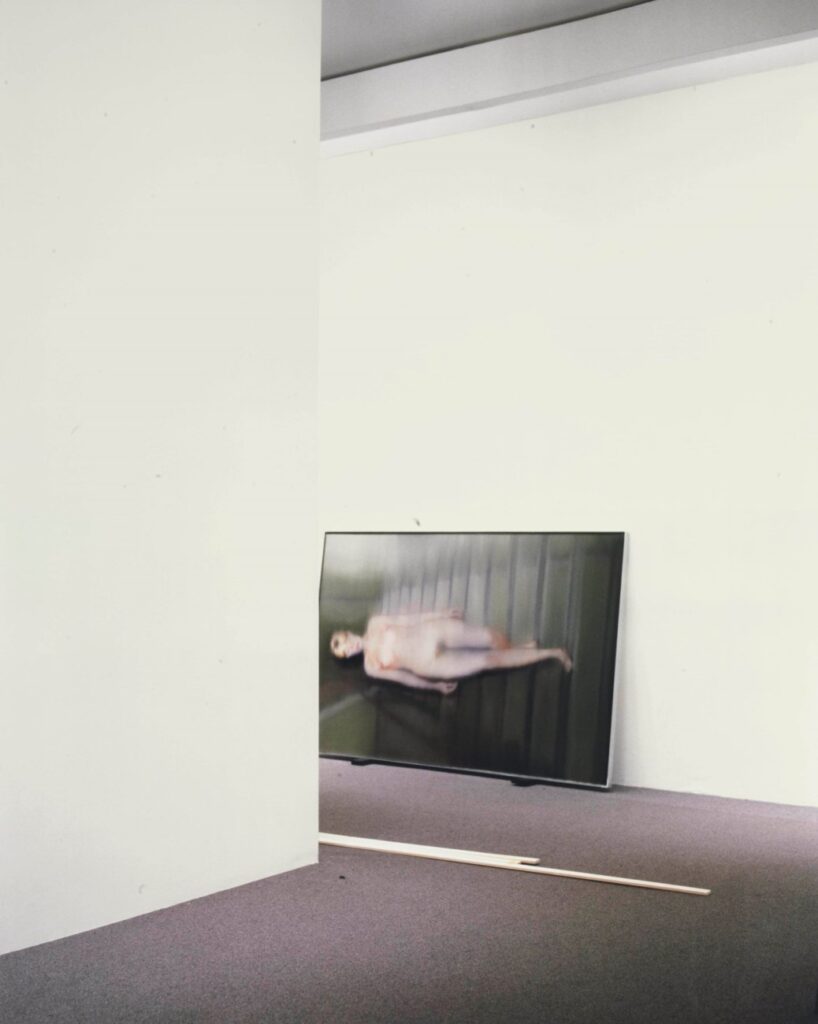
This is one of the Four Nudes Louise Lawler showed at Metro Pictures, beginning on 15 Febrary 2003, the date of a worldwide protest march in which millions and millions of people protested the fraudulent escalation toward the US-led war in Iraq.
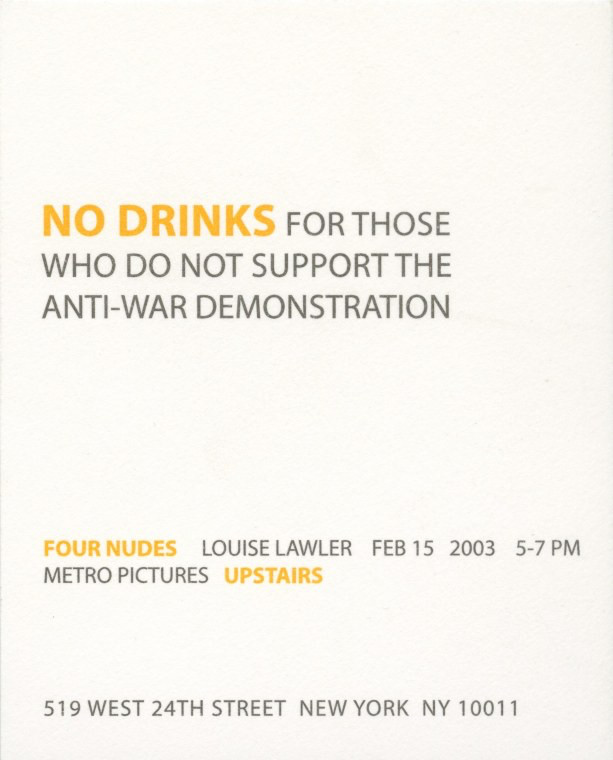
Isaac Fuller Portrait Do-Over
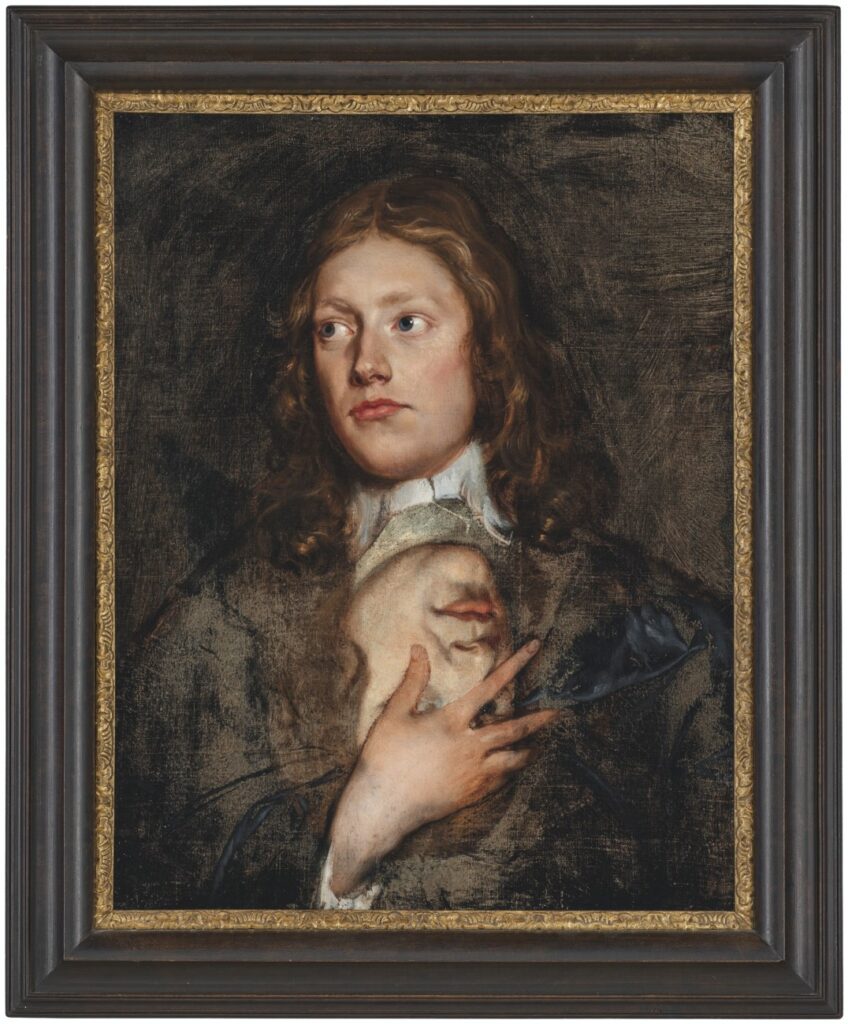
I don’t know anything about 17th century English painter Isaac Fuller, except that he has a dozen paintings attributed to him at the National Portrait Gallery. And, according to the brief text accompanying this painting at Christie’s in 2021, he was a “flamboyant painter,” and a “notorious drunkard” with a “bohemian lifestyle” whose fresco in All Souls at Oxford was “too full of nakeds” to last, and whose last series of works consisted of “decorative schemes” for a string of taverns he frequented.
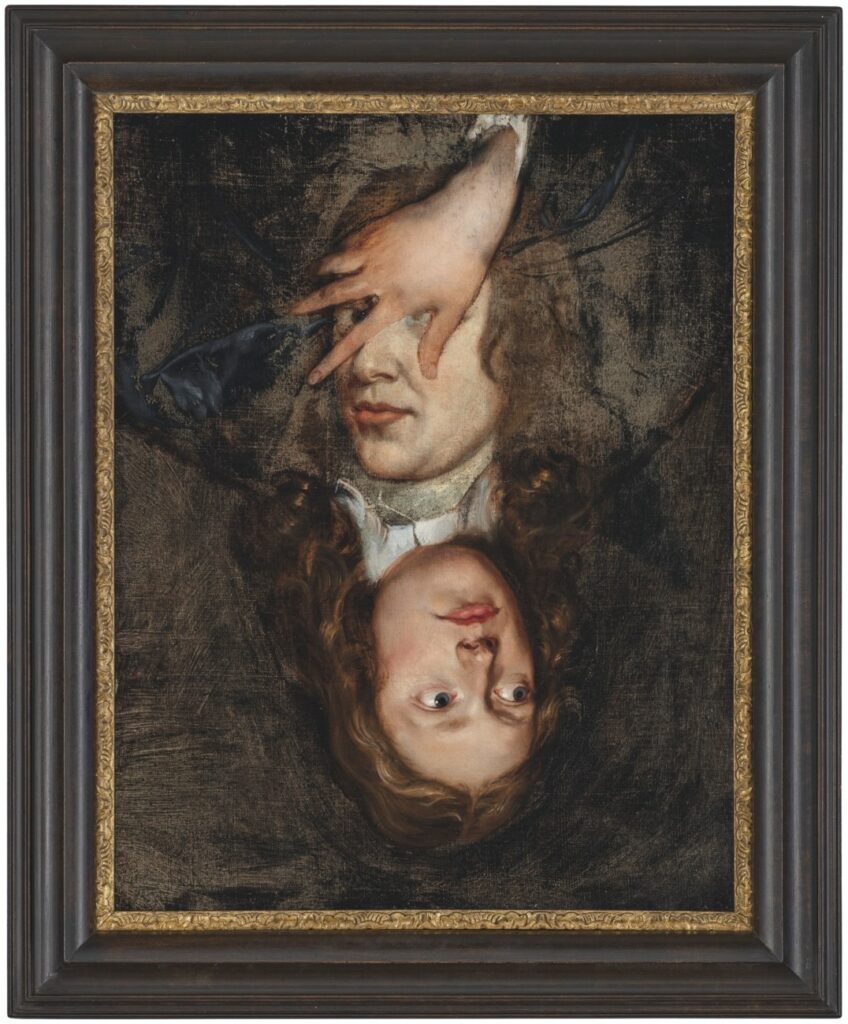
None of that is quite as interesting as this picture, two pictures, really, one on top of and around the other. The portrait underneath, which is now upside down, was uncovered in a recent restoration, says Christie’s. The way it’s been uncovered to keep as much of each portrait intact does make it feel like a deliberate composition, not just an overpainting. Like that extraordinary Ludolf Backhuysen seascape painted around that Isaack Luttichuys portrait that Simon Dickinson brought to TEFAF this year.
What was up in the late 17th century that painters were piling paintings on top of each other, though?
Jonas Would Never

Unless you pay this man $399 so he can surveil you and everything and everyone you see, he’ll never be able to afford Jonas Wood paintings, and will have to keep buying large edition benefit prints.
All Jack Pierson’s World’s A Stage
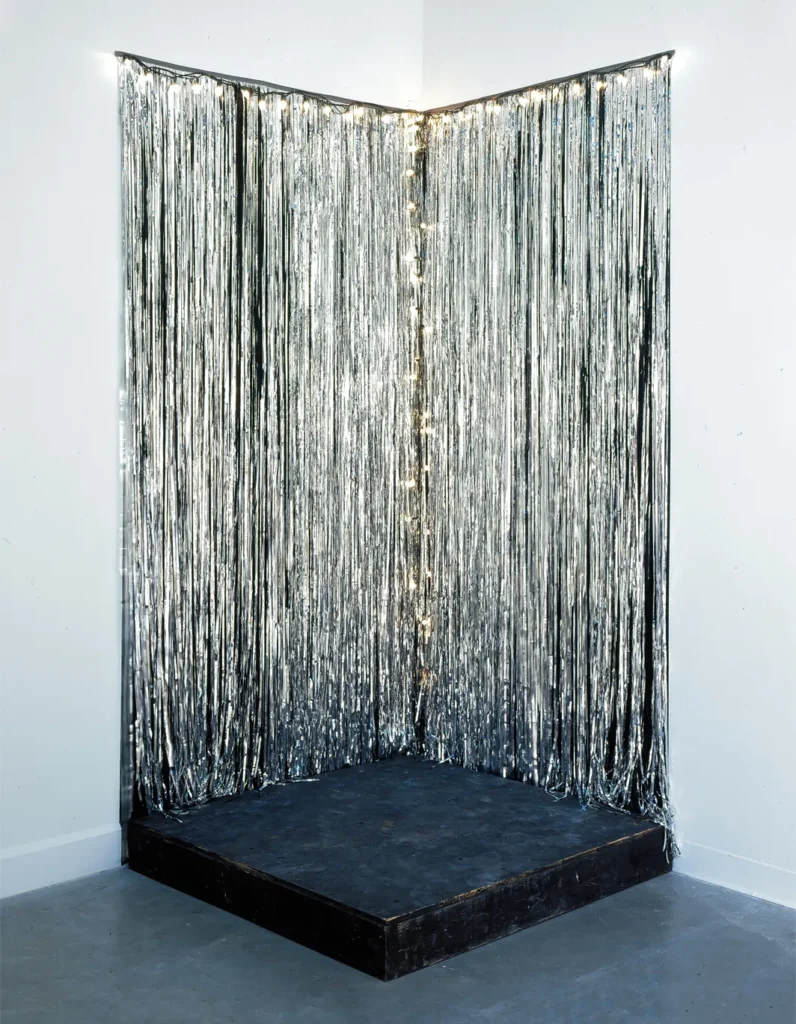
Speaking of go-go dancing platforms and light strings, I cannot get out of my head the confluence of Jack Pierson showing Silver Jackie at Pat Hearn less than a month after Felix Gonzalez-Torres showed “Untitled” (Go-Go Dancing Platform) at Andrea Rosen.
Pierson’s show was called Diamond Life, and it was the 30-yo artist’s nostalgic lament for the squalid glory of his lost youth. In the main gallery of Hearn’s third-floor Wooster St walkup, Pierson staged a recreation of his apartment from his early 20s Miami beach bum era. And in the back was this tiny, abject, artificially aged stage—Pierson’s always called it a stage, I think—which called out his punk and performance art days in Boston.
The Aspen Art Museum re-staged Pierson’s first five shows in 2016. David Rimanelli wrote most generously about Silver Jackie in 2021, when it was on the cover of Artforum. Rather than influence or interaction, or two nearly simultaneous critiques of Michael Fried’s Minimalist theatricality (derogatory), the more I look at these two ostensibly similar works, the more I think they were two artists who happened to be dancing at the same time, but to their own tunes.
Window, McMansion, Randolph
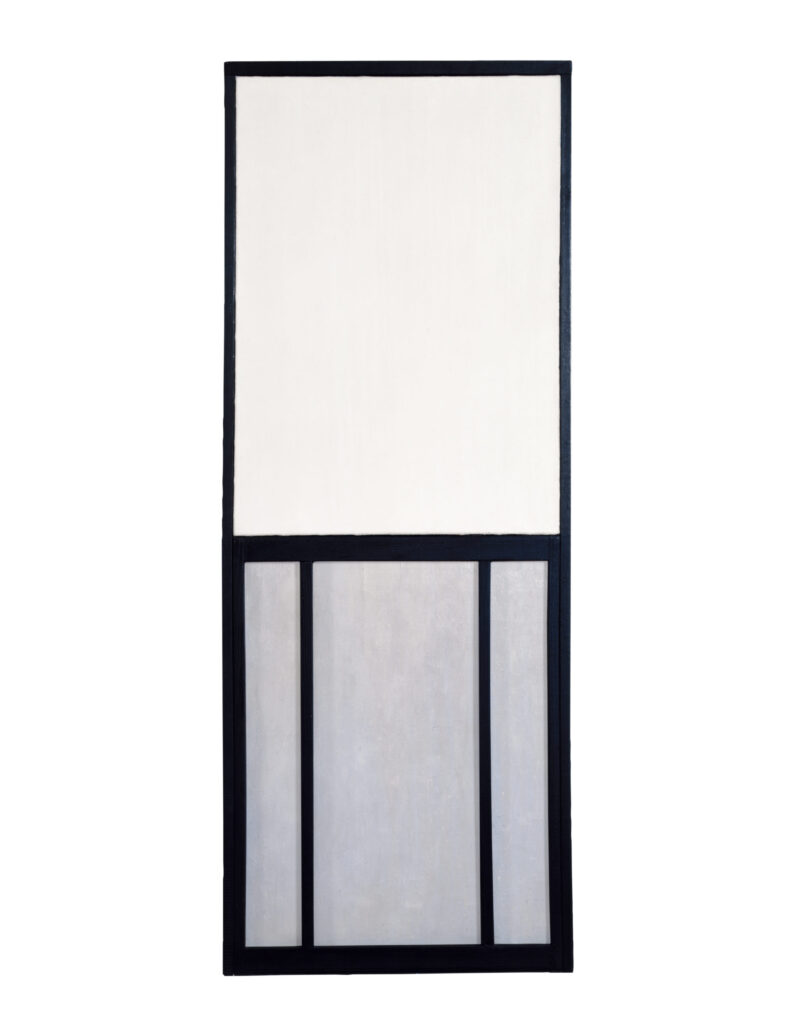
In our timeline, in October 1949, Ellsworth Kelly, a young former soldier studying painting on the GI Bill, saw the windows of the Museum of Modern Art in Paris in a new way, as a composition, one that could become a painting/object just as it was, and in fact, the whole world was like that, full of subjects he could spend his whole life discovering and transforming into paintings.

In another timeline, a young Ellsworth Kelly saw these two off-the-shelf prairie mullion windows kludged together to look like one tall, misaligned, window on a house in the middle of a gravel field in North Carolina that was just posted on McMansion Hell, and drove straight to the army to re-enlist as a requisitions compliance auditor, eventually retiring from a job at a cubicle in Ring C of the Pentagon. His little yard is full of old stoves, which he salvages from apartment turnovers, repairs, and sells on Facebook.
Window, Museum of Modern Art, Paris, 1949 [ellsworthkelly.org]
glam metal modern but also your contractor is going to jail dawg [mcmansionhell]
Beuys Collector Collection Shelf

After working with Joseph Beuys on his multiples for many years, Jörg Schellmann made small editions of four pieces of Beuys-designed furniture in 2008, 22 years after the artist’s death.
Schellmann Art’s description says all these pieces—three tables and a bookshelf, no vitrines, no felt—were originally made in 1953 for an unidentified collector in Dusseldorf. I’m not sure why they’re being so cagey. In 1953 Beuys’s two major collectors were brothers: Hans and Franz Josef van der Grinten. Besides collecting his work, the van der Grintens gave Beuys his first show, in their house, let him move in with them, and represented him in their gallery. Was it somehow not them?
The original table Beuys made was later incorporated into an artwork, and then into Block Beuys, the seven-room gesamtkunstinstallationwerk at the Hessisches Landesmuseum in Darmstadt. A controversial renovation and conservation project, including a March 2008 symposium on what to do with the original jute wallcoverings and carpets, was the immediate context, if not the specific impetus, for the collection. [spoiler alert: they’re still gone.]
Anyhow, I like this shelf more than I expected. And I like how the lighting in this example, which sold for much less than retail at Phillips in April 2020, right in the mouth of the pandemic, shows the ladder-like structure.
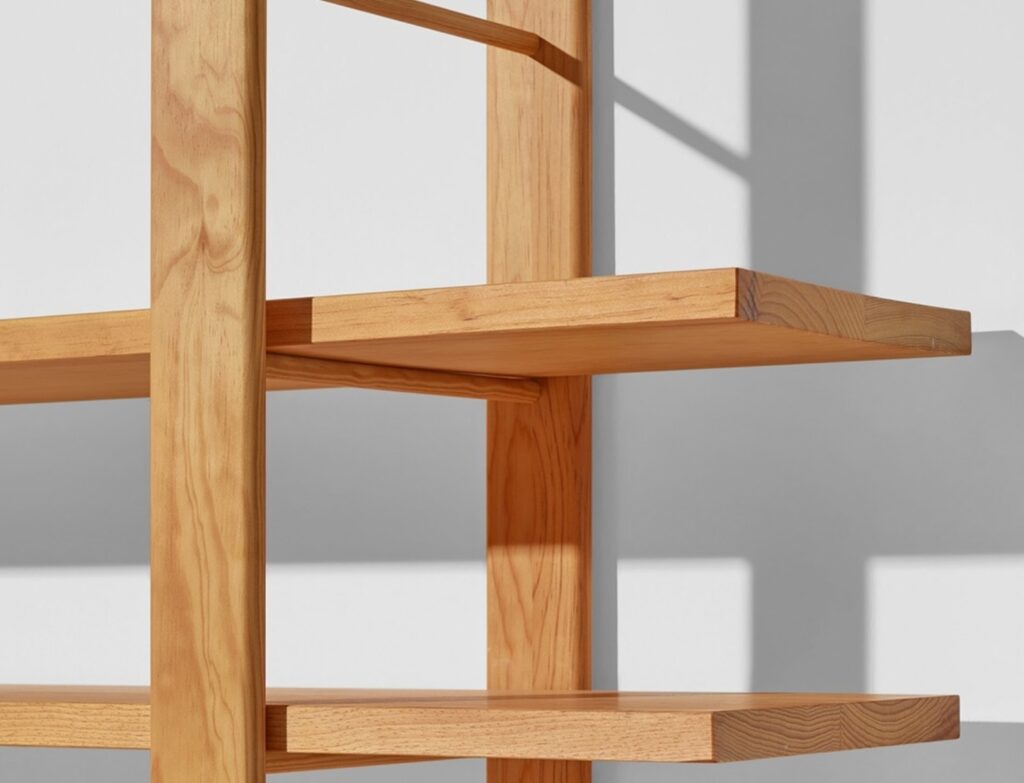
If you can’t wait for another to turn up, the form could be replicated in Ikea IVAR components, but not its details. Though the shelves look to be straight up lumber. And built up? The verticals are pinned to the wall, and are rounded, but and the shelves are neither. The desks all have extensive joinery, so though the carpentry details that will keep the whole thing from wobbling itself to death in actual use are not apparent, there must be something. Right?
Joseph Beuys, Royal Pitch Pine, 1953/2008 [schellmannart]
Maurice Darantiere, Ulysses Cover Proof
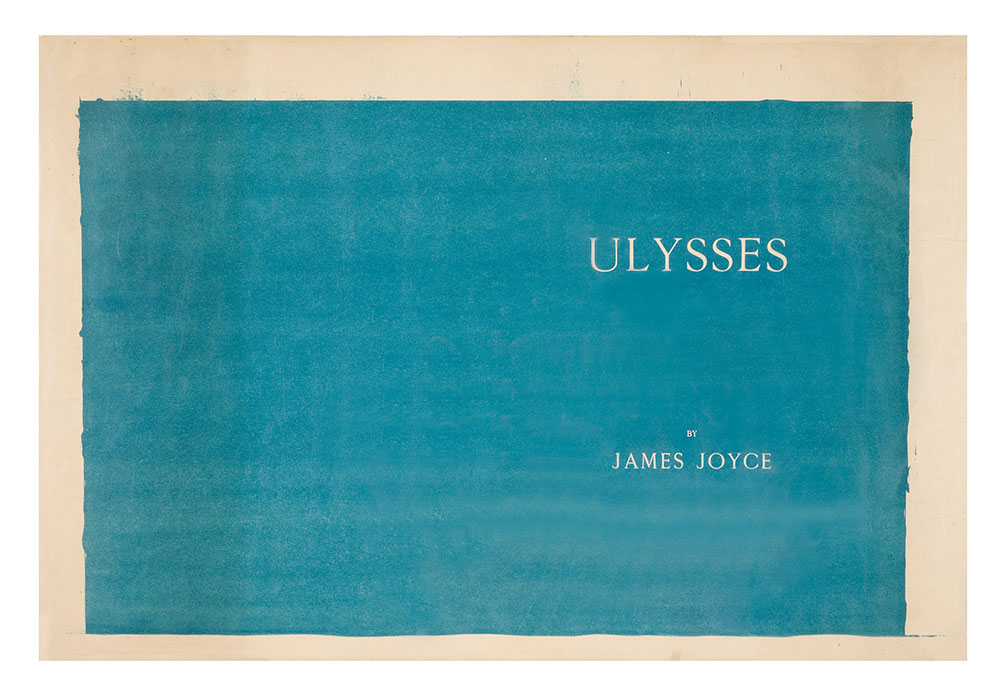
I knew the story about Joyce wanting the cover for Ulysses to be the blue of the Greek flag. But I did not know that he ended up giving the little Greek flag hanging in Shakespeare & Co. to his artist friend, Myron Chester Nutting, to match the color.
I learned this from The Morgan Library’s online exhibition celebrating Ulysses‘ centenary, which includes the extraordinary lithograph above, the final proof for Joyce’s Ulysses cover, prepared by the Dijon printer Maurice Darantiere.
At first the bleed around the edge and the brushmarks made me wonder if there was an ur-monochrome painting, a Nutting original, but I think not. The stone or the plate was painted with a solid field, which Darantiere printed using ink prepared to Nutting’s specification. The title seems to be set in negative, masked so the unprinted paper shows through.
Maybe I must now make the entire cover, as printed, not just the front. I feel like it should match the dimensions of the book, and the page inside, but those bleeding edges do call to me. Either way, I obviously must make it like this now.
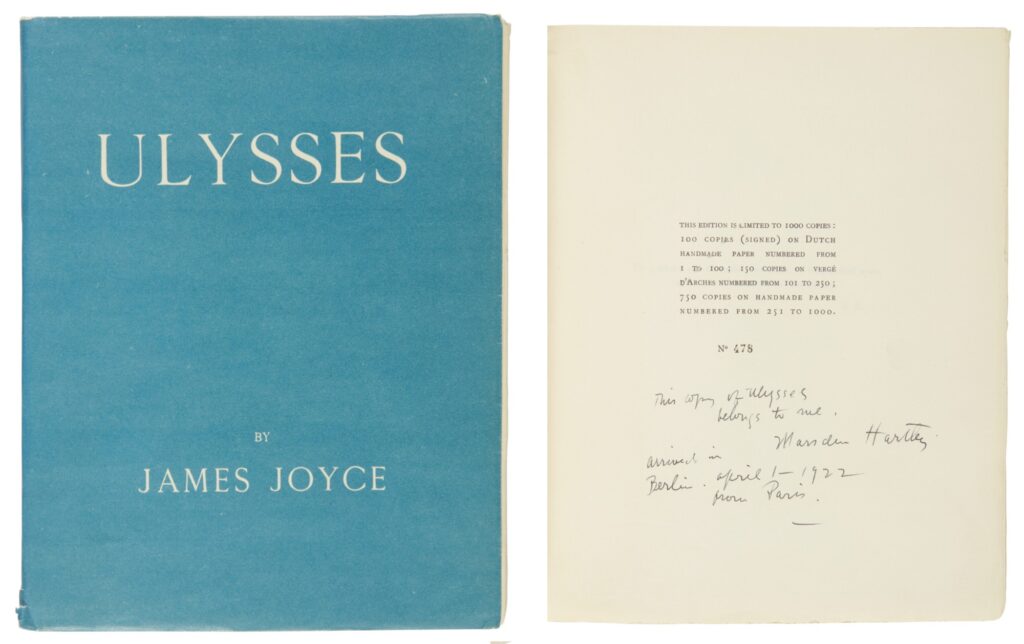
And I have to get the color right. Is it best to match the modern color of Marsden Hartley’s copy? Is it even possible to match the original, given that they’re all 100 years old, too? Do I try to match the proof? Is it a Ulysses conservation standardbearer? Nutting apparently warned Joyce that the blue would fade, and it did?
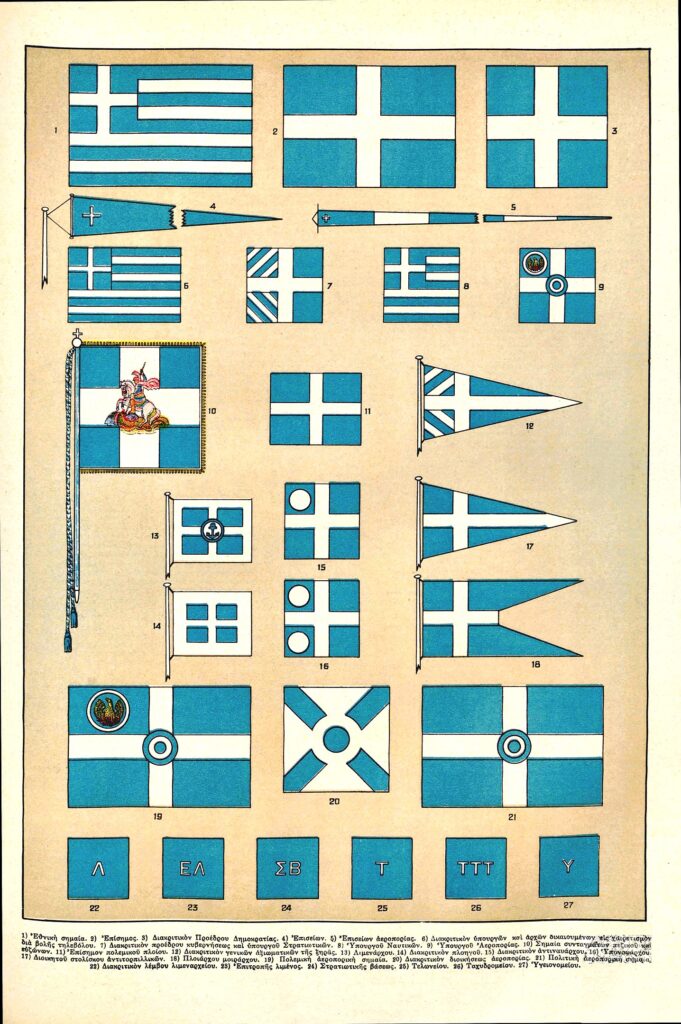
I’ve seen discussion of Joyce’s Greek flag blue not actually matching the Greek flag’s blue, that perhaps the Shakespeare & Co. flag had faded, as well as the books. But Ulysses matches the color of the Greek flags reproduced in this 1934 encyclopedia plate. Honestly, I can see the appeal.
Getting the Right Blue on the Cover [themorgan.org via @mclees-fiona via @joshuajfriedman]
Previously, related: Untitled (Joyce Hartley), 2025
At least Luigi Lucioni got his copy of Ulysses back
Tania Bruguera Terror Chic
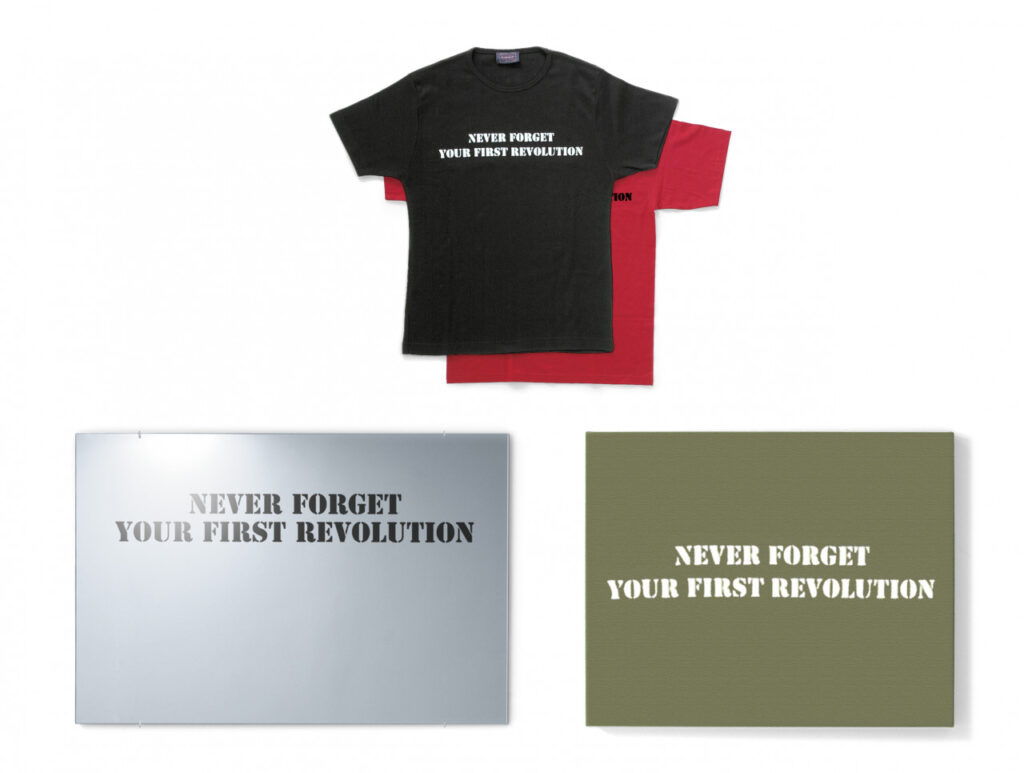
Coming in 2005, smack in the middle of the Global War On Terror™, the 51st Venice Biennale may have been #toosoon for Tania Bruguera to drop two editions named Terror Chic. Twenty years and a few revolutions in, let’s see how it’s going.
One edition is what we might now call the Terror Chic Capsule Collection: a group of fifty objects—mirrors, messenger bags, t-shirts, stretched canvases—each printed with what Edition Schellmann calls Bruguera’s “thought-provoking slogan, ‘NEVER FORGET YOUR FIRST REVOLUTION.'”
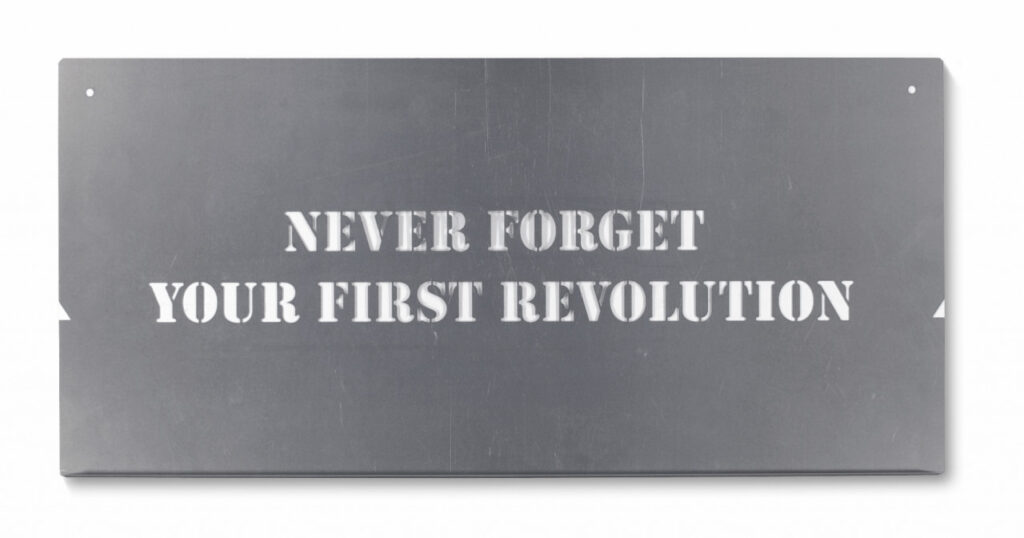
The other is more interesting: a Terror Chic metal stencil in an edition of 200, “to be used to print slogan on T-shirt, bag, wall, car, or any other object.” Now we’re talking. Bruguera’s stencil hasn’t even sold out yet, but it’s efficiency and durability have surely already spawned several revolutions, as well as a whole trend of fundraising edition stencils.
Meanwhile, if you’re in the market, never forget to shop around. The revolution can be had with a vip discount.
Wade Guyton Beyeler Facsimile Objects
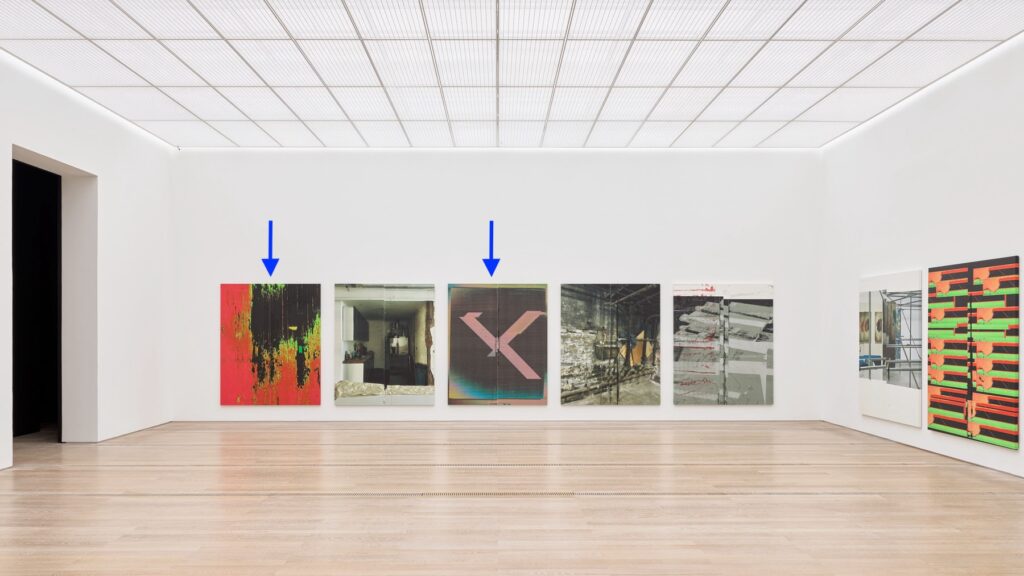
The Fondation Beyeler has just come out with your first Art Basel impulse purchase: two full-scale Wade Guyton prints of paintings showing at the Beyeler right now. Around here we’d call them facsimile objects, but they are very much what Wade does and how he does it.
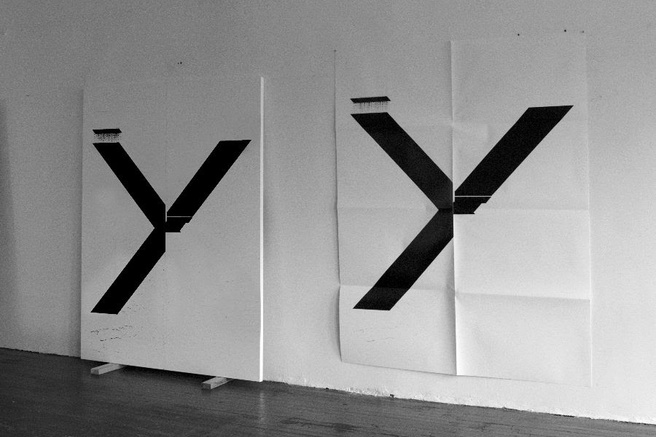
For six years, from 2014-19, Guyton made full-scale print facsimiles of his paintings as fundraising editions for Printed Matter. They were all posters of earlier black X-on-white paintings, and folding them by hand felt like part of the concept. From the proofs installed at the Beyeler, that does not seem to be the case anymore. These look as flat as the day they rolled off the Epson.

TFW I thought I’d seen these before, not just at the Beyeler, and I was like, “Duh, that’s his MO.” But no, I don’t mean in the “all Guytons look alike” mode. I mean in the sense that I felt like I’d seen these paintings before, at Guyton’s 2023 show at Matthew Marks. The X painting, WG5707, depicts a different scan of a different, earlier X painting than the one at Marks. And in fact, the 2024 Beyeler painting in the 2025 Beyeler print has striations that look like a photo of a monitor of a scan of a transparency of a painting, rather than just a scan of a transparency of a painting.
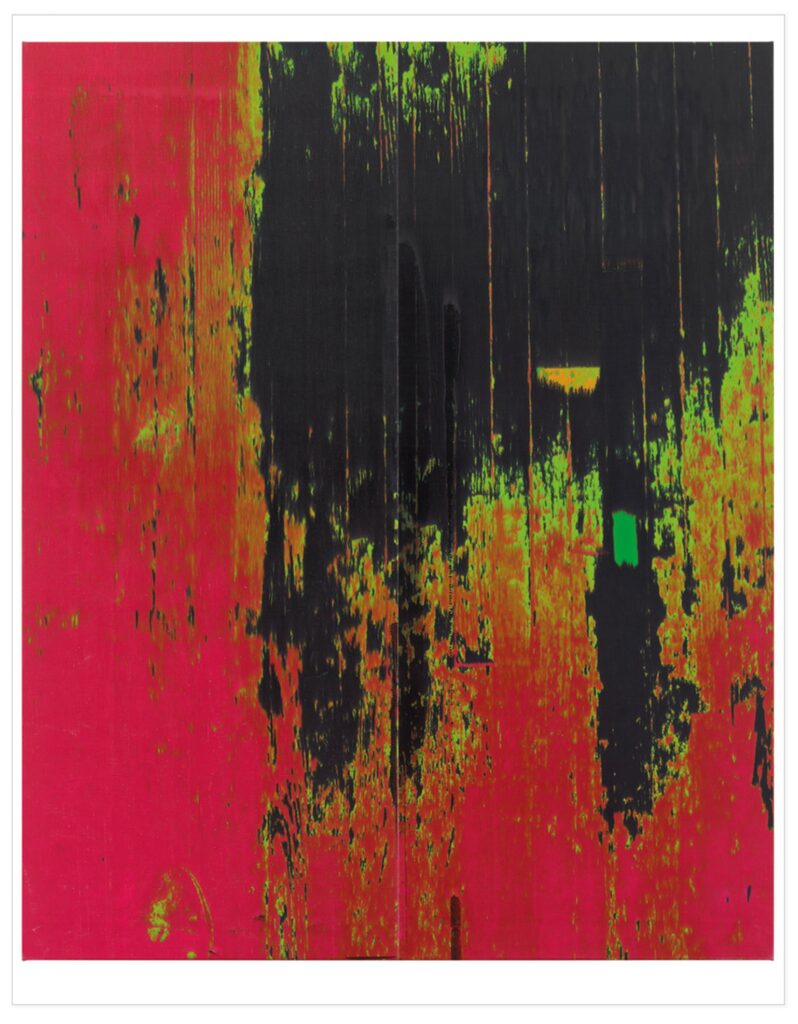
But the other one, WG5703, the photo of Guyton’s studio floor, is, in fact, the same photo, though not the same painting.

Guyton likes to paint, photograph, and repaint the floor of his studio, and these Clyfford Still-like layered abstractions are the glorious result. But what these two paintings show is not found wear & tear. The tape, the shoe[?] in the lower left corner, the separations [not just layering, it turns out] of color. This is the same photo, in different states, printed on canvas, twice. Three times, actually; the Beyeler already has another variation from 2021.
For a long time, Guyton was known to use the same files [.doc, .tiff], and give attention to the accidents and variations of the printing process. He staged multiple shows with identical layouts of images made from the same monochrome image, bigblack.tiff, and even sent five nearly identical paintings to his five dealers spread out around the Messe at Basel.
But from observing these little differences in the same content, Guyton has expanded his source image folder to include screenshots of the Times, and photos of his studio, his work, and his life. His 2021 show at Marks in LA included images of Guyton recording his temperature. In 2023 there were paintings made of photos of protests, and a Manet ham.
As the vagaries of printing become absorbed into the language of his work, Guyton has expanded what he says by making work of what he sees. His work, his shows, images, and the world around him, have all become animating subjects of his mature process. Mature, but not static; processes are revealed in between the finding and the printing. As these two floor paintings show, the images flowing around him may also be manipulated, altered, and created.
At first I thought the recursiveness was new, too, but I think it was always there; the works, their shifting formats, their nested titles, their numbering system, all make us aware of the artist’s awareness. The beauty of that churn, that cycle, of making and showing and remaking, is a compelling subject for at least a hundred people going to Basel for the 20th or 30th time for buying and selling. One hundred plus ten artist proofs.
Previously, related:
Waderunner
Wade Guyton [Manet] Simulacrum Facsimile Object
It’s the little differences
